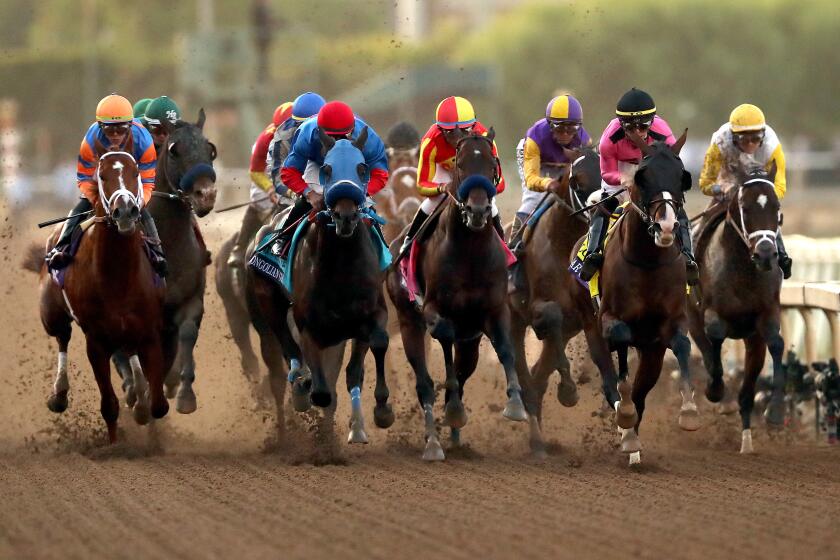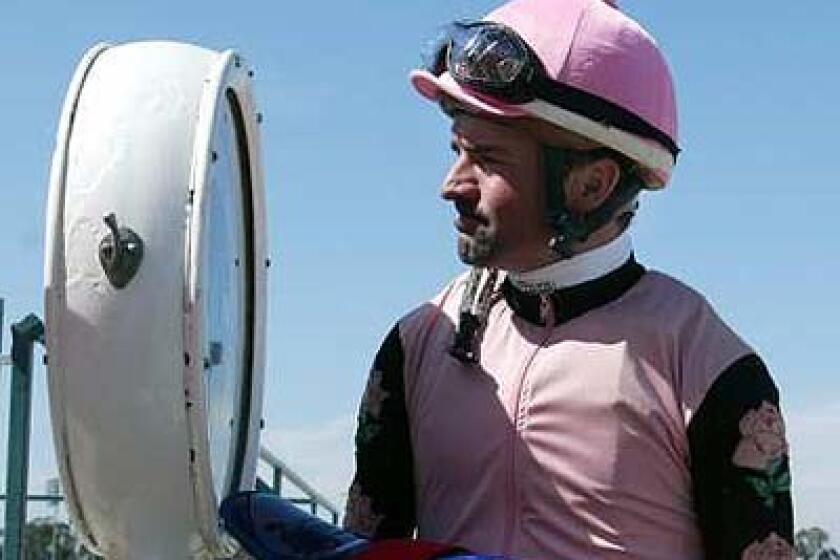State board offers more proposals to improve horse racing safety
- Share via
DEL MAR — In a move designed to answer Gov. Gavin Newsom’s call for change, the California Horse Racing Board announced Thursday a series of proposals in an effort to improve safety and public perception.
Under criticism in the wake of a spike in equine fatalities and how it handled a positive drug test from last year’s Triple Crown winner Justify, the board is proposing statutory changes that would make positive drug tests public within 24 hours, earmark all revenue from licenses and penalties to welfare and safety issues, and greater access and transparency to veterinary records.
Other discussion points, which would not need statutory changes, include stricter veterinarian protocols, elimination of shock wave therapy, more out-of-competition testing, a review of penalty guidelines and fatality information posted on its website, which is set to launch Jan. 1.
The governor hasn’t seen the proposal, according to Russ Heimerich, deputy secretary/communications for the Business Consumer Services and Housing Agency, the group that oversees the CHRB.
“There could be additions, there could be some subtractions,” Heimerich said of the proposals. “I do know there has to be substantial changes in horse racing for it to survive in California. The idea here is to make racing as safe as it can possibly be by changing the way we do things.”
The horse racing industry announces the formation of the Thoroughbred Safety Coalition in hopes of restoring public confidence in the sport.
Its monthly meeting at times looked like a scene from a Federico Fellini movie as about a dozen animal rights activists, most dressed in black funereal garb and veils holding red roses and makeshift tombstones, tried to dominate many of the discussions. They used the public comment period in eight of the 27 agenda items, making 36 speeches, many of them calling for the end of horse racing.
There were seven speeches from the audience that supported horse racing or initiatives by the board. Animal rights activists and horse racing proponents occasionally verbally sparred with each other and at one point Rick Baedeker, executive director of the CHRB, reminded everyone that the CHRB had the authority to clear the room.
The meeting lasted 4 hours and 24 minutes, not counting a one-hour lunch.
The meeting started with the election of a new chairman and vice-chair. Former chairman Chuck Winner declined to be reappointed and vice-chair Madeline Auerbach resigned in the midst of the governor’s concerns over conflicts of interest. Auerbach is a California breeder and owner.
The process, according to those familiar with it but not authorized to speak publicly, started with the governor indicating he wanted Fred Maas as chair and Oscar Gonzales as vice-chair. Maas, who has had conflicts with Gonzales, did not want him as vice-chair and announced he did not want to be reappointed when his term expired Jan. 1. Dr. Greg Ferarro, a veterinarian and Newsom appointee, was then the choice for chairman.
Ferraro was elected unanimously and Gonzales received all the votes except from Maas, who voted no.
The most controversial issue on the agenda, the adoption of a rule that restricted the use of the riding crop (or whip), was tabled until the December meeting. Gonzales said in light of the formation of the Thoroughbred Safety Coalition this week that the CHRB should take extra time to come up with something that hopefully can be a model for the nation.
Hall of fame jockey Kent Desormeaux and longtime jockey Martin Garcia have left more because of lack of opportunity than any concern over the future of California racing.
There was much discussion of giving Santa Anita a license and the board added provisions that the track must follow, including no racing or training when the track is deemed unsafe, horses that have corticosteroid injections in the fetlock not train for 10 days and not race for 30, and there are no races under $10,000 claiming.
In addition, Aidan Butler, acting executive director of California Racing for the Stronach Company, said “we don’t intend to bring back” sprint racing on Santa Anita’s downhill 6 1/2-furlong turf course. However, the track is working with the California Thoroughbred Trainers to examine the historical data in regard to safety of the track.
Butler also said there is an ongoing discussion about Santa Anita adding a synthetic track, but decisions “will not be knee jerk and instead based on data and science.”
More to Read
Go beyond the scoreboard
Get the latest on L.A.'s teams in the daily Sports Report newsletter.
You may occasionally receive promotional content from the Los Angeles Times.













